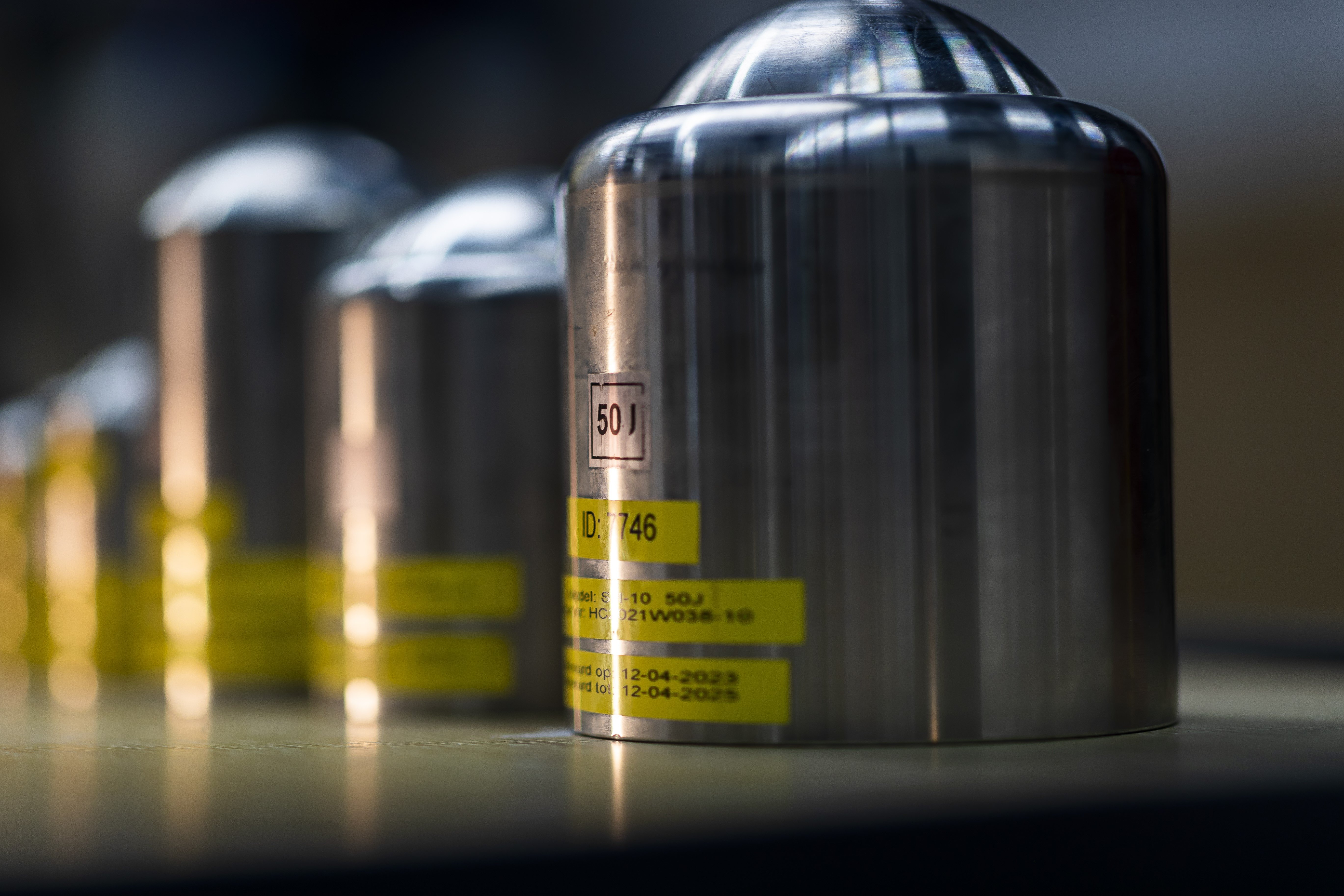IK-testen (Impact Protection Class)
IK testing is performed for various reasons, all aimed at ensuring the quality, durability, and safety of enclosures and equipment.
Navigeer naar:
→ Overview tests
→ More information IK testing
→ Reasons to test

Types of Vertical Hammer testing:
- Standard document: IEC 62262:2002 - Class IK10
- Test standard: IEC 60068-2-75:2014, Section 7 – Method Ehc (Vertical Hammer)
- Impact energy: 20 joules (±5%)
- Equivalent weight: 5 kg (±2%)
- Drop height: 400 mm (±1%)
- Number of impacts: 5 on each exposed surface unless otherwise specified in the relevant product standard. Maximum of 3 impacts in the same location.
- Mounting method: Normally mounted on a rigid support or placed against a rigid backing.
- Functionality: Pass/Fail (depending on the relevant product specification).
- Test result: The test object is subjected to visual, dimensional, and functional inspections as prescribed in the relevant specification. Acceptance criteria are defined in the product standard.
- Standard document: IEC 62262:2002 - Class IK09
- Test standard: IEC 60068-2-75:2014, Section 7 – Method Ehc (Vertical Hammer)
- Impact energy: 10 joules (±5%)
- Equivalent weight: 5 kg (±2%)
- Drop height: 200 mm (±1%)
- Number of impacts: 5 on each exposed surface unless otherwise specified in the relevant product standard. Maximum of 3 impacts in the same location.
- Mounting method: Normally mounted on a rigid support or placed against a rigid backing.
- Functionality: Pass/Fail (depending on the relevant product specification).
- Test result: The test object is subjected to visual, dimensional, and functional inspections as prescribed in the relevant specification. Acceptance criteria are defined in the product standard.
- Standard document: IEC 62262:2002 - Class IK08
- Test standard: IEC 60068-2-75:2014, Section 7 – Method Ehc (Vertical Hammer)
- Impact energy: 5 joules (±5%)
- Equivalent weight: 1.7 kg (±2%)
- Drop height: 300 mm
- Number of impacts: 5 on each exposed surface unless otherwise specified in the relevant product standard. Maximum of 3 impacts in the same location.
- Mounting method: Normally mounted on a rigid support or placed against a rigid backing.
- Functionality: Pass/Fail (depending on the relevant product specification).
- Test result: The test object is subjected to visual, dimensional, and functional inspections as prescribed in the relevant specification. Acceptance criteria are defined in the product standard.
- Standard document: IEC 62262:2002 - Class IK07
- Test standard: IEC 60068-2-75:2014, Section 7 – Method Ehc (Vertical Hammer)
- Impact energy: 2 joules (±5%)
- Equivalent weight: 0.5 kg (±2%)
- Drop height: 400 mm (±1%)
- Number of impacts: 5 on each exposed surface unless otherwise specified in the relevant product standard. Maximum of 3 impacts in the same location.
- Mounting method: Normally mounted on a rigid support or placed against a rigid backing.
- Functionality: Pass/Fail (depending on the relevant product specification).
- Test result: The test object is subjected to visual, dimensional, and functional inspections as prescribed in the relevant specification. Acceptance criteria are defined in the product standard.
- Standard document: IEC 62262:2002 - Class IK10+
- Test standard: IEC 60068-2-75:2014, Section 7 – Method Ehc (Vertical Hammer)
- Impact energy: 50 joules (±5%)
- Equivalent weight: 10 kg (±2%)
- Drop height: 500 mm (±1%)
- Number of impacts: 5 on each exposed surface unless otherwise specified in the relevant product standard. Maximum of 3 impacts in the same location.
- Mounting method: Normally mounted on a rigid support or placed against a rigid backing.
- Functionality: Pass/Fail (depending on the relevant product specification).
- Test result: The test object is subjected to visual, dimensional, and functional inspections as prescribed in the relevant specification. Acceptance criteria are defined in the product standard.
Types of Vertical Hammer
- Standard document: IEC 62262:2002 - Class IK06
- Test standard: IEC 60068-2-75:2014, Section 6 – Method Ehb (Spring Hammer)
- Impact energy: 1 joule (±10%)
- Equivalent weight: 0.25 kg (±2%)
- Number of impacts: 5 on each exposed surface unless otherwise specified in the relevant product standard. Maximum of 3 impacts in the same location.
- Mounting method: Normally mounted on a rigid support or placed against a rigid backing.
- Functionality: Pass/Fail (depending on the relevant product specification).
- Test result: The test object is subjected to visual, dimensional, and functional inspections as prescribed in the relevant specification. Acceptance criteria are defined in the product standard.
- Standard document: IEC 62262:2002 - Class IK05
- Test standard: IEC 60068-2-75:2014, Section 6 – Method Ehb (Spring Hammer)
- Impact energy: 0.7 joules (±10%)
- Spring compression: 24 mm (±1%) (Spring constant 2.75 x 10³ N/m)
- Number of impacts: 5 on each exposed surface unless otherwise specified in the relevant product standard. Maximum of 3 impacts in the same location.
- Mounting method: Normally mounted on a rigid support or placed against a rigid backing.
- Functionality: Pass/Fail (depending on the relevant product specification).
- Test result: The test object is subjected to visual, dimensional, and functional checks as prescribed in the relevant specification. Acceptance criteria are defined within the specification.
- Standard document: IEC 62262:2002 - Class IK04
- Test standard: IEC 60068-2-75:2014, Section 6 – Method Ehb (Spring Hammer)
- Impact energy: 0.5 joules (±10%)
- Spring compression: 20 mm (±1%) (Spring constant 2.75 x 10³ N/m)
- Number of impacts: 5 on each exposed surface unless otherwise specified in the relevant product standard. Maximum of 3 impacts in the same location.
- Mounting method: Normally mounted on a rigid support or placed against a rigid backing.
- Functionality: Pass/Fail (depending on the relevant product specification).
- Test Result: The test object is subjected to visual, dimensional, and functional checks as prescribed in the relevant specification. Acceptance criteria are defined within the specification.
- Standard document: IEC 62262:2002 - Class IK03
- Test standard: IEC 60068-2-75:2014, Section 6 – Method Ehb (Spring Hammer)
- Impact energy: 0.35 joules (±10%)
- Spring compression: 17 mm (±1%) (Spring constant 2.75 x 10³ N/m)
- Number of impacts: 5 on each exposed surface unless otherwise specified in the relevant product standard. Maximum of 3 impacts in the same location.
- Mounting method: Normally mounted on a rigid support or placed against a rigid backing.
- Functionality: Pass/Fail (depending on the relevant product specification).
- Test result: The test object is subjected to visual, dimensional, and functional checks as prescribed in the relevant specification. Acceptance criteria are defined within the specification.
- Standard document: IEC 62262:2002 - Class IK02
- Test standard: IEC 60068-2-75:2014, Section 6 – Method Ehb (Spring Hammer)
- Impact energy: 0.2 joules (±10%)
- Spring compression: 13 mm (±1%) (Spring constant 2.75 x 10³ N/m)
- Number of impacts: 5 on each exposed surface unless otherwise specified in the relevant product standard. Maximum of 3 impacts in the same location.
- Mounting method: Normally mounted on a rigid support or placed against a rigid backing.
- Functionality: Pass/Fail (depending on the relevant product specification).
- Test result: The test object is subjected to visual, dimensional, and functional checks as prescribed in the relevant specification. Acceptance criteria are defined within the specification.
- Standard document: IEC 62262:2002 - Class IK01
- Test standard: IEC 60068-2-75:2014, Section 6 – Method Ehb (Spring Hammer)
- Impact energy: 0.14 joules (±10%)
- Spring compression: 10 mm (±1%) (Spring constant 2.75 x 10³ N/m)
- Number of impacts: 5 on each exposed surface unless otherwise specified in the relevant product standard. Maximum of 3 impacts in the same location.
- Mounting method: Normally mounted on a rigid support or placed against a rigid backing.
- Functionality: Pass/Fail (depending on the relevant product specification).
- Test result: The test object is subjected to visual, dimensional, and functional checks as prescribed in the relevant specification. Acceptance criteria are defined within the specification.
Additional information about IK-testen
IK testing is conducted to classify the degree of mechanical protection provided by enclosures against external impacts, as defined in the IEC 62262 standard. This standard provides a standardized classification, the IK rating, which indicates the level of impact resistance of an enclosure.
Key points about IK testing:
- Specifies the classification of protection grades against mechanical impacts.
- Applicable to equipment with a nominal voltage of up to 72.5 kV.
- Used in various applications, such as industrial machinery, electrical panels, and other enclosures.
- Mechanical impacts are simulated using specific impact hammers and test elements.
- These tests measure the enclosure's resistance to different types of strikes and forces.
- The IK rating ranges from IK00 (no protection) to IK10 (very high protection).
- Each level corresponds to a specific impact energy, expressed in joules.
- Examples of IK ratings:
- IK05: 0.7 joules
- IK07: 2 joules
- IK10: 20 joules
- Testing involves using a drop hammer or pendulum with a weight released from a standardized height to create the impact energy.
- Widely used in industrial sectors, construction projects, and electrical engineering.
- Helps assess the durability of equipment and determine its suitability for harsh or high-risk environments.
- Ensures that equipment can withstand damage caused by accidental impacts or vandalism.
- Guarantees reliability and safety in challenging working conditions.
IK-testing (Impact Protection Class)
IK-testing is carried out for various reasons, all aimed at ensuring the quality, durability and safety of enclosures and equipment.

Here are the main reasons why IK testing is crucial:
- Devices and their enclosures are often exposed to impacts, drops, and other mechanical stresses. IK testing simulates these scenarios to verify whether the enclosure can withstand such forces.
- This is especially critical in demanding environments such as factories, public spaces, or outdoor installations.
- Mechanical damage can lead to hazards such as exposed wiring, short circuits, or system failures.
- By testing impact resistance, the safety of users and the environment is guaranteed.
- Many industries require compliance with international standards like IEC 62262.
- Achieving a specific IK classification demonstrates that a product meets stringent requirements and is suitable for specific applications.
- Equipment with a higher IK classification is generally more durable and resistant to rough handling or unexpected incidents.
- This increases product lifespan and reduces maintenance and replacement costs.
- Each use case has different requirements for impact resistance:
- IK08 or higher: Suitable for public spaces where vandalism is a risk (e.g., parking garages or city lighting).
- IK10: Ideal for extreme conditions, such as industrial installations or sports facilities where heavy impacts are expected.
- IK testing proves that a product has been thoroughly tested and certified.
- This boosts customer and user confidence in the product's quality.
- A higher IK classification can provide a distinguishing advantage in the market, especially in industries where robustness is a critical factor.
Do you have any questions?
Want to learn more about our testing methods or specific tests? Our experts are here to help with any inquiries you might have. Reach out today and find out how the Sebert Group can support you in delivering unmatched quality and reliability.
